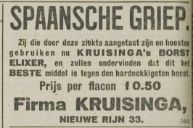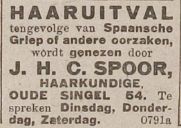Antidote to the Spanish Flu
At the beginning of the twentieth century, the drugstore experienced its first pandemic: the Spanish flu. Above the Delft pottery hangs a photo that – unintentionally – evokes a memory: it shows the drugstore in the year 1918, the year the Spanish Flu erupted.
According to the Algemeen Handelsblad, people sought refuge in all sorts of antidotes, because of the 'unheard of spread and [the] maliciousness' character of the disease.
Drogisterij Boerhaave responded to this demand and advertised 'formamint, paraform and saccharoform tablets' for protection against this terrifying disease - although there was no scientific basis for this claim (fig. 1). Yet, the druggist was not the only one who noticed a new opportunity. For example, the company D.M. Kruisinga on the Nieuwe Rijn placed an advertisement for their 'Kruisinga's breast elixir' (fig. 2) and there was even a 'hair expert', J.H.C. Spoor on the Oude Singel, who claimed to have a cure for the hair loss which was - supposedly - 'a result of [the] Spanish Flu' (fig. 3).


